|
Crotaphopeltis hotamboeia (Red-lipped snake, Herald snake)
Rooilipslang [Afrikaans]; Phimpi [Ndebele]
Life >
Eukaryotes
>
Opisthokonta >
Metazoa
(animals) > Bilateria > Deuterostomia >
Chordata >
Craniata > Vertebrata (vertebrates) > Gnathostomata (jawed vertebrates) >
Teleostomi (teleost fish) > Osteichthyes (bony fish) > Class:
Sarcopterygii (lobe-finned fish) > Stegocephalia (terrestrial vertebrates) >
Tetrapoda
(four-legged vertebrates) > Reptiliomorpha > Amniota >
Reptilia (reptiles) >
Romeriida > Diapsida > Lepidosauromorpha > Lepidosauria >
Squamata > Serpentes
(snakes) > Family: Colubridae > Subfamily:
Colubrinae > Genus:
Crotaphopeltis
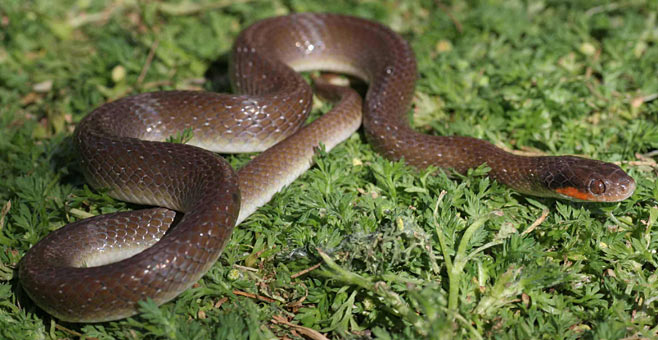 |
|
Crotaphopeltis hotamboeia (Red-lipped
snake, Herald snake), Gauteng. [D. Koen ©, from
SARCA
Virtual Museum] |
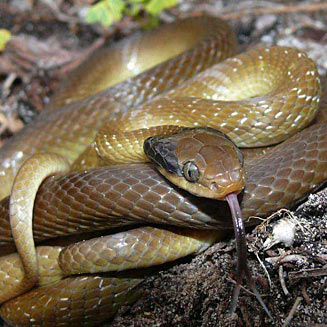 |
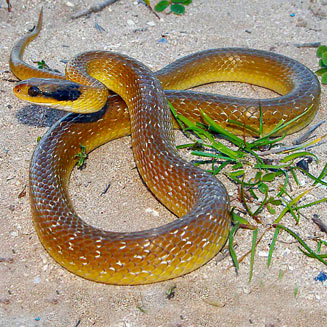 |
|
Crotaphopeltis hotamboeia (Red-lipped
snake, Herald snake), Western Cape. [A. Rebelo
©, from
SARCA
Virtual Museum] |
Crotaphopeltis hotamboeia (Red-lipped
snake, Herald snake), Western Cape. [R.W. Leslie
©, from
SARCA
Virtual Museum] |
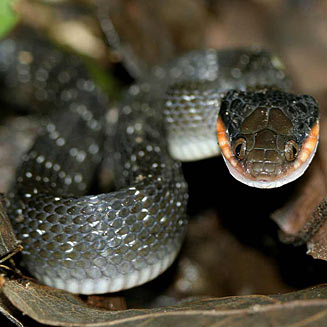 |
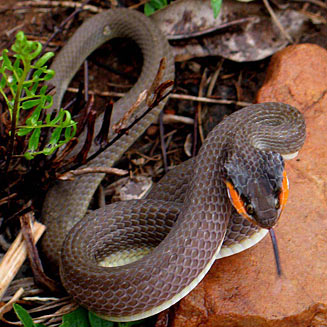 |
|
Crotaphopeltis hotamboeia (Red-lipped
snake, Herald snake), Eastern Cape. [D. Stuart-Fox and A. Moussalli
©, from
SARCA
Virtual Museum] |
Crotaphopeltis hotamboeia (Red-lipped
snake, Herald snake), Gauteng. [R. Marais
©, from
SARCA
Virtual Museum] |
Identification
This snake species can be identified by its olive green or
grey body, multiple white speckles, its distinctive black head and red, yellow,
white or black upper lip. It grows to an average length of 70 cm but may reach
up to 1 meter in length.
Distribution and habitat
The Herald snake is widespread and is present throughout
South Africa (except for the Karoo and Northern Cape), It is also present
throughout Lesotho, Swaziland, Zimbabwe, Southern and Central Mozambique and
Northern Botswana. It favoured habitats are marshy areas in lowland forest, moist
savanna, grasslands and fynbos.
Food
Feeds on
amphibians
(including
rain frogs), lizards and other snakes (only in captivity).
Predators, parasites and disease
Fed on by other snakes.
Spiders
in the genus
Latrodectus (widows and buttonspiders) have been recorded as natural
enemies.
Reproduction
Oviparous (egg laying), lays between 6 and 19 eggs in early
summer.
Longevity
Has been known to live for between 10 and 15 years.
Medical importance
This snake's venom has only minor effects and is not
dangerous at all. No antivenom is required.
Links
References
-
Broadley, D.G. 1983. FitzSimons' Snakes of Southern
Africa. Delta Books, Johannesburg.
-
Marais, J. 2004. A Complete Guide to Snakes of Southern Africa.
Struik Publishing, Cape Town.
|
